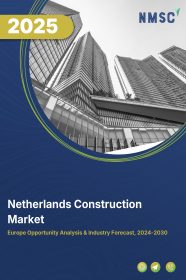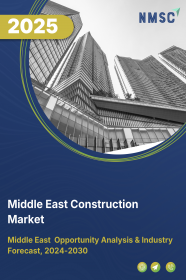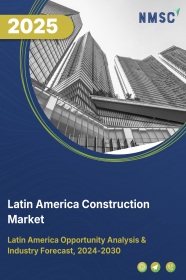
Netherlands Construction Market by Type (Renovation, and New Construction), by Construction Method (Traditional, Prefabricated/Modular, 3D-Printed, and Green/Sustainable), by Contractor Type (Large Contractor, Medium Contractor, and Small Contractor), and Sector (Real Estate, Commercial, Infrastructure, Industrial) – Industry Trends and Forecast, 2025–2030
Industry: Construction & Manufacturing | Publish Date: 09-Jun-2025 | No of Pages: 85 | No. of Tables: 118 | No. of Figures: 63 | Format: PDF | Report Code : CM2204
Netherlands Construction Industry Overview
The Netherlands Construction Market size was valued at USD 710 million in 2024, and is projected to grow to USD 770 million by 2025. Additionally, the industry is expected to continue its growth trajectory, reaching USD 995 million by 2030, with a CAGR of 5.2% from 2025 to 2030.
The Netherlands construction market is experiencing significant growth driven by major infrastructure projects, such as the Hollandse Kust Noord Wind Farm, the Porthos CO2 Capture and Storage Project, and the Zuidasdok Project, among others. These initiatives are bolstered by substantial investments, which have contributed to the sector’s increasing share of the country's GDP.
However, the market faces challenges due to complex regulatory frameworks and lengthy permitting processes that hinder project timelines and increase costs. At the same time, the growing adoption of Building Information Modeling (BIM) and the integration of digital technologies like AI, IoT, and cloud solutions are creating new growth opportunities by enhancing collaboration, accuracy, and resource efficiency in project execution.
Major Infrastructure Projects Fuel the Netherlands Construction Market Growth
The construction market in Netherlands is experiencing substantial growth, fueled by a surge in major infrastructure endeavors. Prominent projects include the USD 2 billion Hollandse Kust Noord Wind Farm (759 MW), completed in Q4 2024, now supplying renewable energy to the national grid; the USD 726 million Porthos CO2 Capture and Storage Project, with construction starting in 2024 to store 2.5 million tonnes of CO2 annually under the North Sea by 2026; the USD 1.4 billion Zuidasdok Project in Amsterdam, advancing in 2024 to modernize the A10 South motorway and Amsterdam Zuid railway station; the USD 366 million Tesla Megapack Battery Storage Facility in Vlissingen, contracted in 2025 to build a 1.4 GW facility by 2027; and the USD 1.2 billion Blankenburg Connection (A24), progressing in 2024 to connect the A20 and A15 highways, enhancing Rotterdam’s port accessibility. These projects, supported by the Dutch Ministry of Infrastructure and Water Management, are pivotal in driving the expansion of the infrastructure industry.
Significant Contribution to GDP Boosts the Netherlands Construction Market Demand
The Netherlands construction market share is also attributed to the significant growth of the construction market, which holds a substantial portion of the Netherlands’ GDP. According to Statistics Netherlands (CBS), the construction and infrastructure sector accounted for 5.1% of the country’s GDP in 2024, surpassing contributions from European nations such as Greece and Ireland.
This growth is driven by a 2% increase in construction output in 2024, with infrastructure investments reaching USD 208.5 billion, a 20% rise from 2023, as reported by the National Association of Building Contractors (ANCE). Key initiatives, including the USD 2.51 billion Project Beethoven in 2024 to enhance the Brainport Eindhoven region’s chip industry infrastructure and the National Water Program’s USD 1 billion investment in flood prevention, underscore the sector’s critical role in the Dutch economy.
Regulatory Challenges Hindering Netherlands Construction Market Expansion
The construction market faces significant hurdles due to regulatory complexities that stem from stringent frameworks. Infrastructure ventures encounter obstacles arising from a complex network of government regulations and permitting processes. Infrastructure projects require securing numerous permits and approvals from governmental bodies at local, regional, and national levels, covering zoning regulations, environmental assessments, building codes compliance, safety standards, and various regulatory requirements.
Lengthy permit acquisition processes, bureaucratic inefficiencies, and regulatory disparities among jurisdictions can considerably extend project timelines and increase costs. Moreover, fluctuations in regulations or unexpected policy changes can disrupt ongoing projects and deter potential investments.
Integration of Digitalization and BIM Presents Lucrative Opportunity for the Market Expansion
The construction industry is undergoing a major digital transformation, fueled by the growing adoption of Building Information Modeling (BIM), which is creating new growth opportunities. BIM facilitates digital design, simulation, and infrastructure management, enhancing accuracy, collaboration, and resource efficiency. In line with this trend, ALLPLAN introduced Allplan 2024-1 in April 2024 to improve BIM functionality and streamline cloud-based workflows, highlighting the sector's transition to fully digital project execution. Additionally, the integration of AI, IoT, and cloud technologies is enhancing real-time collaboration, enabling predictive maintenance, and optimizing facility management.
Competitive Landscape
The key players operating in the Netherlands construction industry include Heijmans N.V., ROYAL BAM GROUP NV, VolkerWessels, Dura Vermeer, TBI Holdings BV, BESIX, Van Wijnen Group, Hurks, Boskalis, Ballast Nedam, Strukton, DPR Constructions, Van Oord, FCC Construccion, Fluor Corporation, and others.
Netherlands Construction Market Key Segments
By Type
-
Renovation
-
New Construction
By Construction Method
-
Traditional Construction
-
Prefabricated/Modular Construction
-
3D-Printed Construction
-
Green/Sustainable Construction
By Type of Contractor
-
Large Contractor
-
Medium Contractor
-
Small Contractor
By Sector
-
Real Estate
-
Residential
-
Affordable
-
Luxury
-
-
Commercial
-
Retail Buildings
-
Office Buildings
-
Hospitality
-
Healthcare Facilities
-
Educational Institutes
-
Entertainment Ventures
-
-
-
Infrastructure
-
Transportation
-
Airport
-
Port
-
Rail
-
Road
-
-
Water and Wastewater
-
Energy
-
Telecommunication
-
-
Industrial
-
Manufacturing Plant
-
Warehouses
-
Power Plants
-
Oil Refineries
-
Chemical Plants
-
Key Players
-
Heijmans N.V.
-
Royal Bam Group NV
-
VolkerWessels
-
Dura Vermeer
-
TBI Holdings BV
-
BESIX
-
Van Wijnen Group
-
Hurks
-
Boskalis
-
Ballast Nedam
-
Strukton
-
DPR Constructions
-
Van Oord
-
FCC Construccion
-
Fluor Corporation
REPORT SCOPE AND SEGMENTATION:
|
Parameters |
Details |
|
Market Size in 2024 |
USD 710 Million |
|
Revenue Forecast in 2030 |
USD 995 Million |
|
Growth Rate |
CAGR of 5.2% from 2025 to 2030 |
|
Analysis Period |
2024–2030 |
|
Base Year Considered |
2024 |
|
Forecast Period |
2025–2030 |
|
Market Size Estimation |
Million (USD) |
|
Growth Factors |
|
|
Companies Profiled |
15 |
|
Market Share |
Available for 10 companies |
|
Customization Scope |
Free customization (equivalent up to 80 working hours of analysts) after purchase. Addition or alteration to country, regional, and segment scope. |
|
Pricing and Purchase Options |
Avail customized purchase options to meet your exact research needs. |




















 Speak to Our Analyst
Speak to Our Analyst

























